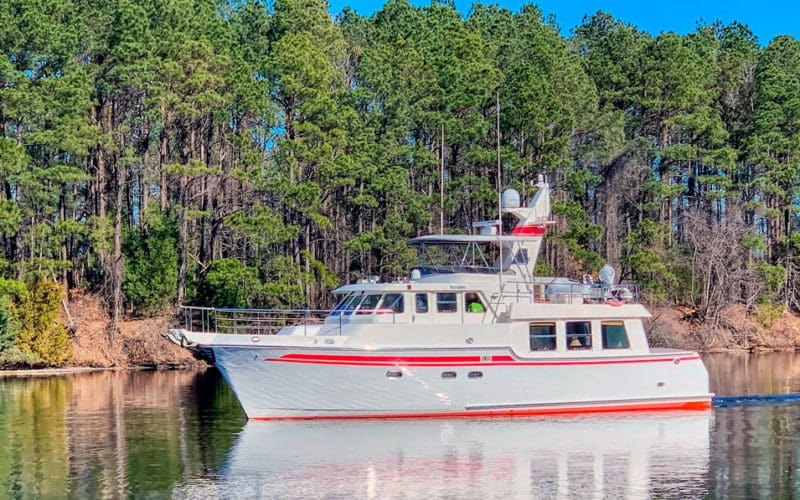
Have you been paying attention to the warning signs on your boat? My guess is that you, like me, have been looking right past several important reminders. I’d like to encourage you to notice, stop and think.
RTFM is my abbreviated code for “read the factory manual.” In the Power Voyaging column of Ocean Navigator, I have advocated for organizing your onboard tools and spare parts. Organizing your manuals is another important project to “dial-in” your trawler.
It must be human nature that we think we can outsmart things and try to figure them out ourselves instead of reading the manual. Almost every product that you have on your boat has an owner or operator manual to explain how it works, but they are rarely consulted.
A veteran cruiser is always prepared. They know their boat and they have the right tools and spares to manage nearly any project along with the documentation on board that explains systems, equipment and components. Owner and/or operator manuals are available for just about every onboard item –– from the toaster in your galley to the windlass on your foredeck. The information contained is invaluable, especially when it comes time to attend to a repair or service. Written instructions can only help you, however, if you read the factory manual.
Reading manuals is normally low on my priority list, and for many males (myself, included) opening a manual for guidance is like asking for directions while driving –– I don’t like to do it, to the point where I will spend a lot of extra/wasted time relying on my own faulty intellect and intuitive reasoning to seek a solution. It’s always easier if you can be shown how something works rather than figuring it out on your own, and this is where a manual can help save you time and frustration.
Most savvy trawler owners keep their hard copy paper manuals divided in plastic bins and in three ring binders for instant reference. These collections are typically organized by area or function –– galley gear, nav/com electronics, machinery, etc. –– so they can be located when needed. The same follows for individual equipment manuals: engine, transmission, generator, stabilizers, windlass, thrusters, etc.
With the convenience of digital PDF storage, consider downloading the manuals you need to your iPad or tablet as a way to save limited physical storage space for more essential provisions.
I’d like to commend two trawler builders, Kadey-Krogen and Nordhavn, for providing an operator manual with each new boat they build. These compendiums are logically organized and contain detailed explanations, systems diagrams, parts, service intervals, tools to have and vendor resources.
When I work with clients who have purchased one of these trawlers, I make sure they understand how these manuals can assist and educate. I like to pull out the drawings and manuals to help supplement my teaching. I will ask them, for example, to explain to me how the freshwater system works and watch them look up this information to verify what they know and remind them to search out answers on their own. As you learn about your onboard systems, consider creating your own instructions with sketches of how components are installed and identifying components. In preparation for writing this article, I have been on the hunt for RTFM labels and have been continuously amazed at their prevalence. The universal symbol is a triangle with an exclamation point next to an open book. This visual easily translates across every language. Product manufacturers are warning us to stop, open the book and read the factory manual before proceeding. RTFM reminders are everywhere.
RTFM has become an inside joke I use with my clients during training (sometimes with an alternative use of the letter “f”). By making manuals a priority for my clients, I help them realize they can read and reason to a happy result without needing to seek outside advice. When I get a call from an exasperated client who has a question about something we reviewed and is asking for my help, I will often ask playfully, “Did you RTFM?” Usually this elicits a laugh (I’ve learned how to gauge frustration and sometimes humor doesn’t help) and allows a mental reset of the situation so they can resolve their dilemma. The independence of cruising is better appreciated when you are self-sufficient. Knowing how to figure things out is a big part of the experience whether you are mechanically inclined or not. If in doubt, RTFM.
I’ve shared example images in this story with the hope it will prompt you to discover these on your own boat and cause you to pause and RTFM. To celebrate these graphic reminders, I’ve added a collection of “Warning – Read First” RTFM labels to my JMYS.com website. If you would like to contribute one from your boat, please email me at Jeff@JMYS.com and put RTFM in the subject line along with the photo and your permission for me to publish it online. Thank you! n
Jeff Merrill, CPYB, is the president of Jeff Merrill Yacht Sales, Inc.- www.JMYS.com. He’s a veteran yacht broker who specializes in trawlers. He is an online instructor for Boaters University and has a YouTube channel. Contact him a: Jeff@JMYS.com.

